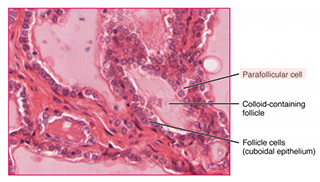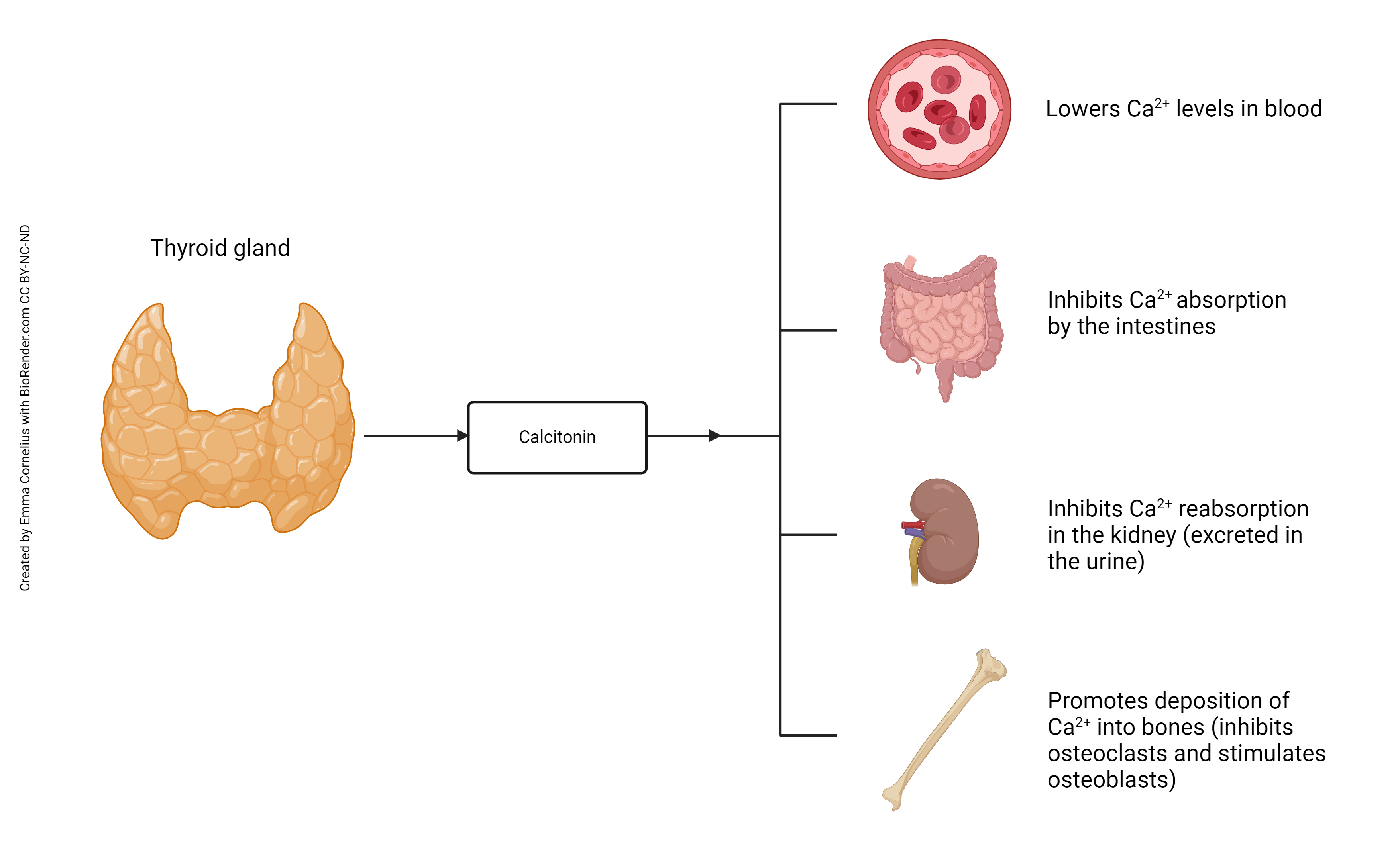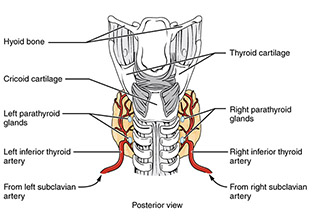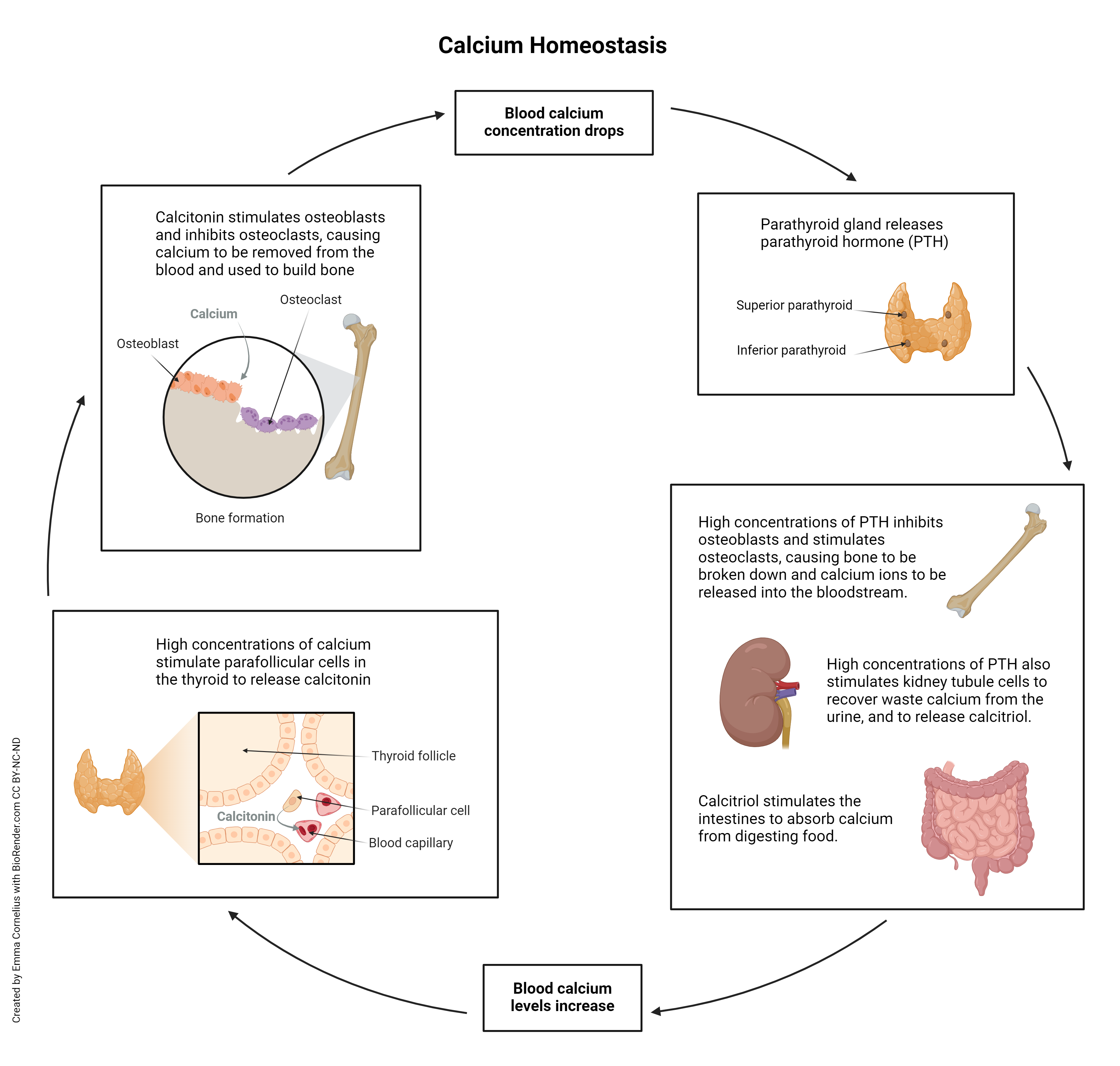Regulation of Blood Calcium | Calcitonin and Parathyroid Hormone
Objective 7
Identify the hormones that regulate blood calcium levels, calcitonin and parathyroid hormone. Describe the glandular and cellular origin of these hormones and their physiological effect.
Calcitonin and parathyroid hormone are antagonistic hormones that regulate blood calcium levels. Remember that antagonistic hormones work opposite of each other to maintain homeostasis. These hormones are not regulated by the pituitary gland.
Bone is a natural reservoir of calcium, so much like depositing or withdrawing money from the bank, calcium is deposited or withdrawn from bone. The hormone calcitonin lowers blood calcium levels; parathyroid hormone raises blood calcium levels.
 Thyrocalcitonin, more commonly just referred to as calcitonin, is produced by the parafollicular cells of the thyroid, also called C cells. The name is actually quite intuitive, thyro- meaning relating to the thyroid, and calcitonin, referring to the fact that its action is to regulate calcium levels. If the name sounds familiar, that’s because you’ve already heard about calcitonin in the skeletal system.
Thyrocalcitonin, more commonly just referred to as calcitonin, is produced by the parafollicular cells of the thyroid, also called C cells. The name is actually quite intuitive, thyro- meaning relating to the thyroid, and calcitonin, referring to the fact that its action is to regulate calcium levels. If the name sounds familiar, that’s because you’ve already heard about calcitonin in the skeletal system.
Calcitonin decreases blood calcium levels by inhibiting the action of osteoclasts and increasing osteoblastic activity, thus depositing calcium from the blood into the bones. Calcitonin also decreases calcium absorption in the intestines and increases the loss of calcium in the urine.

 The parathyroid glands are small masses of partially-embedded endocrine tissue, located on the posterior aspect of the thyroid gland. Typically, there are four parathyroid glands, two on each lobe of the thyroid, one superior and one inferior. The parathyroid glands contain chief (principal) cells, which produce and secrete parathyroid hormone (PTH).
The parathyroid glands are small masses of partially-embedded endocrine tissue, located on the posterior aspect of the thyroid gland. Typically, there are four parathyroid glands, two on each lobe of the thyroid, one superior and one inferior. The parathyroid glands contain chief (principal) cells, which produce and secrete parathyroid hormone (PTH).
The action of PTH is to increase the number and activity of osteoclasts. This causes an increase in bone reabsorption and releases more calcium ions into the blood. PTH also inhibits osteoblasts from building bone. PTH acts on the kidneys by causing increased reabsorption of calcium in the kidney tubules. It also initiates the production of calcitriol in the kidneys, an active form of vitamin D3. Calcitriol in turn, causes more calcium to be reabsorbed in the intestines. All commercially produced milk is fortified with vitamin D. This is to enhance the absorption of calcium from the milk.

Parathyroid hormone increases blood calcium levels when they drop too low. Conversely, calcitonin, which is released from the thyroid gland, decreases blood calcium levels when they become too high. These two mechanisms constantly maintain blood calcium concentration at homeostasis.
Media Attributions
- U14-035 Thyroid Gland © Betts, J. Gordon; Young, Kelly A.; Wise, James A.; Johnson, Eddie; Poe, Brandon; Kruse, Dean H. Korol, Oksana; Johnson, Jody E.; Womble, Mark & DeSaix, Peter adapted by Jim Hutchins is licensed under a CC BY (Attribution) license
- U14-037 Calcitonin © Cornelius, Emma is licensed under a CC BY-NC-ND (Attribution NonCommercial NoDerivatives) license
- U14-036 Parathyroid Gland © Betts, J. Gordon; Young, Kelly A.; Wise, James A.; Johnson, Eddie; Poe, Brandon; Kruse, Dean H. Korol, Oksana; Johnson, Jody E.; Womble, Mark & DeSaix, Peter adapted by Jim Hutchins is licensed under a CC BY (Attribution) license
- U14-038 PTH and Calcium Homeostasis © Cornelius, Emma is licensed under a CC BY-NC-ND (Attribution NonCommercial NoDerivatives) license

